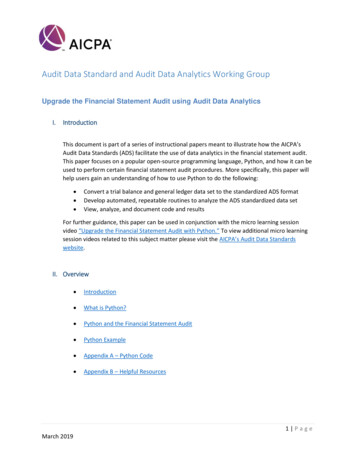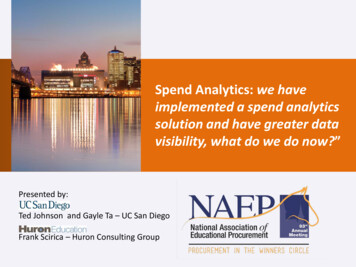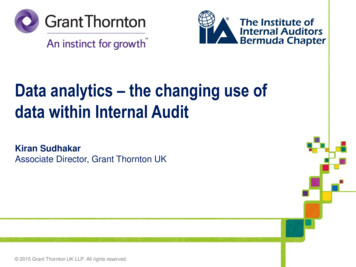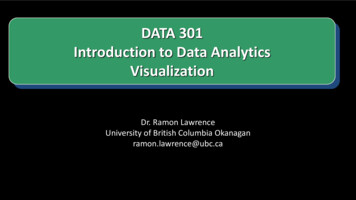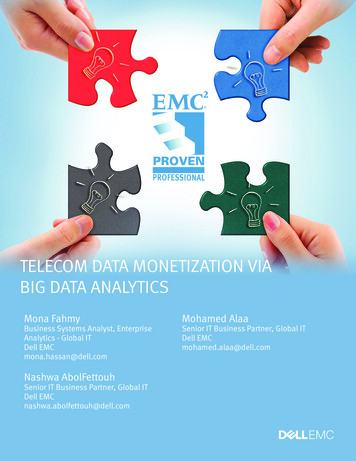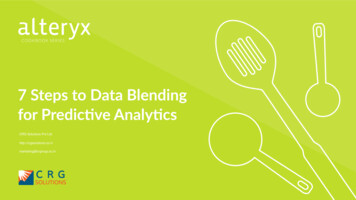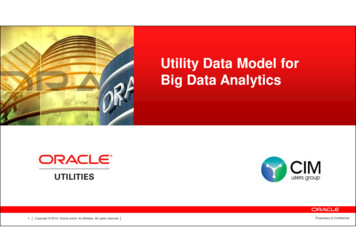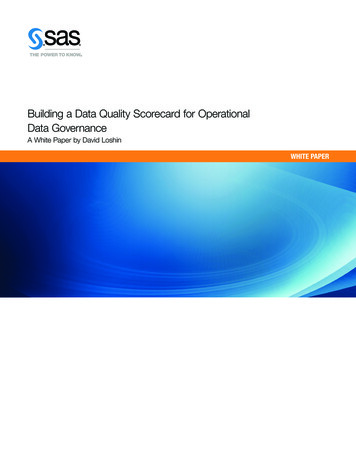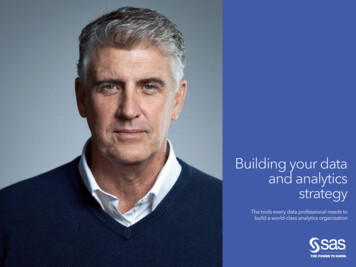
Transcription
Building your dataand analyticsstrategyThe tools every data professional needs tobuild a world-class analytics organization
Building your dataand analyticsstrategyThe tools every data professionalneeds to build a world-classanalytics organization.What’s on the chief data and analyticsofficer’s agenda? Defining and drivingthe data and analytics strategy for theentire organization. Ensuring informationreliability. Empowering data-drivendecisions across all lines of business.Wringing every last bit of value out ofthe data. And that’s just Monday.The challenges are many, but so are theopportunities. This e-book is full of resourcesto help you launch successful data analyticsprojects, improve data prep and go beyondconventional data governance. Read on tohelp your organization become truly datadriven with best practices from TDWI, seewhat an open approach to analytics did forCox Automotive and Cleveland Clinic, andfind out how the latest advances in AI arerevolutionizing operations at Volvo Trucksand Mack Trucks.314IoT data with AI reduces downtime,helps truckers keep on trucking5 ways to become data-driven18710 questions to kick off your data analytics projectsHow to improve data prep for analytics:TDWI shares best practices11Data governance: The case for self-validation21Keeping an open mind about open analytics
5 ways to becomedata-drivenMost organizations believe that dataand analytics provide insights, butfew describe themselves as trulydata-driven.
b u i l d i n g yo u r data a n d a n a ly t i c s st r at e g y5 ways to become data-drivenWhen it comes to being data-driven,organizations run the gamut with maturitylevels. Most believe that data and analyticsprovide insights. But only one-third ofrespondents to a TDWI survey said theywere truly data-driven, meaning they analyzedata to drive decisions and actions.1Successful data-driven businesses foster a collaborative, goal-oriented culture.Leaders believe in data and are governance-oriented. The technology side ofthe business ensures sound data quality and puts analytics into operation. Thedata management strategy spans the full analytics life cycle. Data is accessibleand usable by multiple people – data engineers and data scientists, businessanalysts and less-technical business users.TDWI analyst Fern Halper conducted research of analytics and dataprofessionals across industries and identified the following five bestpractices for becoming a data-driven organization.1. Build relationships to support collaborationIf IT and business teams don’t collaborate, the organization can’t operatein a data-driven way – so eliminating barriers between groups is crucial.Achieving this can improve market performance and innovation; butcollaboration is challenging. Business decision makers often don’t thinkIT understands the importance of fast results, and conversely, IT doesn’tthink the business understands data management priorities. Office politicscome into play.But having clearly defined roles and responsibilities with shared goals acrossdepartments encourages teamwork. These roles should include: IT/architec-Achieve excellence in analytics with the SAS Platformture, business and others who manage various tasks on the business and ITsides (from business sponsors to DevOPs).2. Make data accessible and trustworthyMaking data accessible – and ensuring its quality – are key to breaking downbarriers and becoming data-driven. Whether it’s a data engineer assemblingand transforming data for analysis or a data scientist building a model,everyone benefits from trustworthy data that’s unified and built arounda common vocabulary.As organizations analyze new forms of data – text, sensor, image and streaming – they’ll need to do so across multiple platforms like data warehouses,Hadoop, streaming platforms and data lakes. Such systems may resideon-site or in the cloud. TDWI recommends several best practices to help: Establish a data integration and pipeline environment with tools thatprovide federated access and join data across sources. It helps to havepoint-and-click interfaces for building workflows, and tools thatsupport ETL, ELT and advanced specifications like conditionallogic or parallel jobs. M anage, reuse and govern metadata – that is, the data about your data.This includes size, author, database column structure, security and more. P rovide reusable data quality tools with built-in analytics capabilities that canprofile data for accuracy, completeness and ambiguity.3. Provide tools to help the business work with dataFrom marketing and finance to operations and HR, business teams needself-service tools to speed and simplify data preparation and analytics tasks.Such tools may include built-in, advanced techniques like machine learning,and many work across the analytics life cycle – from data collection andprofiling to monitoring analytical models in production. These “smart”tools feature three capabilities:TOC4
5 ways to become data-driven Automation helps during model building and model management processes. Data preparation tools often use machine learning and natural languageprocessing to understand semantics and accelerate data matching. Reusability pulls from what has already been created for data managementand analytics. For example, a source-to-target data pipeline workflowcan be saved and embedded into an analytics workflow to create apredictive model. E xplainability helps business users understand the output when, forexample, they’ve built a predictive model using an automated tool.Tools that explain what they’ve done are ideal for a data-driven company.b u i l d i n g yo u r data a n d a n a ly t i c s st r at e g y5. Use modern governance technologiesand practicesGovernance – that is, rules and policies that prescribe how organizationsprotect and manage their data and analytics – is critical in learning to trustdata and become data-driven. But TDWI research indicates that one-third oforganizations don’t govern their data at all. Instead, many focus on securityand privacy rules. Their research also indicates that fewer than 20 percent oforganizations do any type of analytics governance, which includes vetting andmonitoring models in production.4. Consider a cohesive platform that supportscollaboration and analyticsAs organizations mature analytically, it’s important for their platform to support multiple roles in a common interface with a unified data infrastructure.This strengthens collaboration and makes it easier for people to do their jobs.For example, a business analyst can use a discussion space to collaborate witha data scientist while building a predictive model, and during testing. The datascientist can use a notebook environment to test and validate the model asit’s versioned and metadata is captured. The data scientist can then notify theDevOps team when the model is ready for production – and they can use theplatform’s tools to continually monitor the model.Achieve excellence in analytics with the SAS PlatformTOC5
5 ways to become data-drivenDecisions based on poor data – or models that have degraded – can havea negative effect on the business. As more people across an organizationaccess data and build models, and as new types of data and technologiesemerge (big data, cloud, stream mining), data governance practices need toevolve. TDWI recommends three features of governance software that canstrengthen your data and analytics governance: D ata catalogs, glossaries and dictionaries. These tools often includesophisticated tagging and automated procedures for building andkeeping catalogs up to date – as well as discovering metadata fromexisting data sets. D ata lineage. Data lineage combined with metadata helps organizationsunderstand where data originated and track how it was changedand transformed. M odel management. Ongoing model tracking is crucial for analyticsgovernance. Many tools automate model monitoring, schedule updatesto keep models current and send alerts when a model is degrading.b u i l d i n g yo u r data a n d a n a ly t i c s st r at e g yFive Data Managementand Analytics BestPractices for BecomingData-DrivenIn a survey, TDWI found that one-third of organizations don’tgovern their data – and fewer than 20 percent do any type ofanalytics governance. Governance is just one discipline that’sessential for becoming data-driven. Learn more in this checklistreport from TDWI.Download free checklist report nowIn the future, organizations may move beyond traditional governance councilmodels to new approaches like agile governance, embedded governance orcrowdsourced governance. But involving both IT and business stakeholdersin the decision-making process – including data owners, data stewards andothers – will always be key to robust governance at data-driven organizations.As organizations mature analytically, it’s important for the platformto support multiple roles in a common interface with a unified datainfrastructure. This strengthens collaboration and makes it easierfor people to do their jobs.Achieve excellence in analytics with the SAS PlatformTOC6
10 questions tokick off your dataanalytics projectsThere’s no single blueprint forbeginning a data analytics project,but these 10 questions will helpguide you to successBy Phil Simon, author, speaker andnoted technology expert
1 0 q u e st i o n s to k i c k o f f yo u r data a n a ly t i c s p r oj e ct sThere’s no single blueprint for beginning adata analytics project – never mind ensuringa successful one.However, I have found that the following questions help individuals and organizations frame their data analytics projects in instructive ways. Put differently,think of these questions as more of a guide than a comprehensive how-to list.1. I s this your organization’s first attemptat a data analytics project?When it comes to data analytics projects, culture matters.Consider Netflix, Google and Amazon. All things being equal, organizationslike these have successfully completed data analytics projects. Even better,they have built analytics into their cultures and become data-driven businesses.As a result, they will do better than neophytes. Fortunately, first-timers are notdestined for failure. They should just temper their expectations.2. What business problem do you think you’retrying to solve?This might seem obvious, but plenty of folks fail to ask it before jumping in.Note here how I qualified the first question with “do you think.” Sometimesthe root cause of a problem isn’t what we believe it to be; in other words,it’s often not what we at first think.In any case, you don’t need to solve the entire problem all at once by trying toboil the ocean. In fact, you shouldn’t take this approach. Project methodologies (like agile) allow organizations to take an iterative approach and embracethe power of small batches.Achieve excellence in analytics with the SAS Platformb u i l d i n g yo u r data a n d a n a ly t i c s st r at e g y3. What types and sources of data are available to you?Most if not all organizations store vast amounts of enterprise data. Looking atinternal databases and data sources makes sense. Don’t make the mistake ofbelieving, though, that the discussion ends there.External data sources in the form of open data sets (such as data.gov) continueto proliferate. There are easy methods for retrieving data from the weband getting it back in a usable format – scraping, for example. This tactic canwork well in academic environments, but scraping could be a sign of dataimmaturity for businesses. It’s always best to get your hands on the originaldata source when possible.Caveat: Just because the organization stores it doesn’t mean you’ll be able toeasily access it. Pernicious internal politics stifle many an analytics endeavor.4. W hat types and sources of data are you allowed to use?With all the hubbub over privacy and security these days, foolish is the soulwho fails to ask this question. As some retail executives have learned in recentyears, a company can abide by the law completely and still make people feeldecidedly icky about the privacy of their purchases. Or, consider a health careorganization – it may not technically violate the Health Insurance Portabilityand Accountability Act of 1996 (HIPAA), yet it could still raise privacy concerns.Another example is the GDPR. Adhering to this regulation means that organizations won’t necessarily be able to use personal data they previously could use– at least not in the same way.5. What is the quality of your organization’s data?Common mistakes here include assuming your data is complete, accurate andunique (read: nonduplicate). During my consulting career, I could count onone hand the number of times a client handed me a “perfect” data set. While it’simportant to cleanse your data, you don’t need pristine data just to get started.As Voltaire said, “Perfect is the enemy of good.”TOC8
b u i l d i n g yo u r data a n d a n a ly t i c s st r at e g y1 0 q u e st i o n s to k i c k o f f yo u r data a n a ly t i c s p r oj e ct s6. What tools are available to extract,clean, analyze and present the data?This isn’t the 1990s, so please don’t tell me that your analytic efforts arelimited to spreadsheets.Sure, Microsoft Excel works with structured data – if the data set isn’t all thatbig. Make no mistake, though: Everyone’s favorite spreadsheet programsuffers from plenty of limitations, in areas like: H andling semistructured andunstructured data. Tracking changes/version control. Dealing with size restrictions. Ensuring governance. Providing security.For now, suffice it to say that if you’re trying to analyze large, complex datasets, there are many tools well worth exploring. The same holds true forvisualization. Never before have we seen such an array of powerful, affordable and user-friendly tools designed to present data in interesting ways. Forinstance, SAS Visual Analytics, SAS Visual Data Mining and Machine Learning,and several open source tools are just some applications and frameworks thatmake dataviz powerful and, dare I say, cool.Caveat 1: While software vendors often ape each other’s features, don’tassume that each application can do everything that the others can.Caveat 2: With open source software, remember that “free” software couldbe compared to a “free” puppy. To be direct: Even with open source software,expect to spend some time and effort on training and education.7. D o your employees possess the right skillsto work on the data analytics project?The database administrator may well be a whiz at SQL. That doesn’t mean,though, that she can easily analyze gigabytes of unstructured data. Many ofmy students need to learn new programs over the course of the semester,and the same holds true for employees. In fact, organizations often find thatthey need to:Achieve excellence in analytics with the SAS PlatformPhil SimonAuthor, speaker andtechnology expertWhat will an individual, group,department or organizationdo with keen new insights fromyour data analytics projects?Will the result be real action?Or will a report just sit insomeone’s inbox? Provide training for existingemployees. Post the project on sites suchas Kaggle. Hire new employees. All of the above. Contract consultants.Don’t assume that your employees can pick up new applications andframeworks 15 minutes at a time every other week. They can’t.8. What will be done with the results of your analysis?In Analytics: The Agile Way, I penned a case study about how one company’srecruiting head honcho asked me to analyze applicant data in 1999. The company routinely spent millions of dollars recruiting MBAs at Ivy League schoolsonly to see them leave within two years. Rutgers MBAs, for their part, stayedmuch longer and performed much better.Despite my findings, the company continued to press on. It refused to stopgoing to Harvard, Cornell, etc. because of vanity. In his own words, the headof recruiting just “liked” going to these schools, data be damned.TOC9
1 0 q u e st i o n s to k i c k o f f yo u r data a n a ly t i c s p r oj e ct sb u i l d i n g yo u r data a n d a n a ly t i c s st r at e g yFood for thought: What will an individual, group, department or organizationdo with keen new insights from your data analytics projects? Will the result bereal action? Or will a report just sit in someone’s inbox?9. What types of resistance can you expect?You might think that people always and willingly embrace the results ofdata-oriented analysis. And you’d be spectacularly wrong.Case in point: Major League Baseball (MLB) umpires get close ball and strikecalls wrong more often than you’d think. Why wouldn’t they want to improvetheir performance when presented with objective data? It turns out that manydon’t. In some cases, human nature makes people want to reject data and analytics that contrast with their world views. Years ago, before the subscriptionmodel became wildly popular, some Blockbuster executives didn’t want tobelieve that more convenient ways to watch movies existed.Caveat: Ignore the power of internal resistance at your own peril.10. What are the costs of inaction?Sure, this is a high-level query and the answers depend on myriad factors.For instance, a pharma company with years of patent protection will responddifferently than a startup with a novel idea and competitors nipping at itsheels. Interesting subquestions here include: Do the data analytics projects merely confirm what we already know? Do the numbers show anything conclusive? Could we be capturing false positives and false negatives?Think about these questions beforeundertaking data analytics projectsDon’t take the queries above as gospel. By and large, though, experienceproves that asking these questions frames the problem well and sets theorganization up for success – or at least minimizes the chance of a disaster.Achieve excellence in analytics with the SAS PlatformTOC10
Data governance:The case forself-validationWhy you should move beyonda conventional approach todata governance
data governance: the case for self-validationb u i l d i n g yo u r data a n d a n a ly t i c s st r at e g yMost organizations understand the importanceof data governance in concept. But they maynot realize all the multifaceted, positive impactsof applying good governance practices to dataacross the organization. For example, ensuringthat your sales and marketing analytics relieson measurably trustworthy customer datacan lead to increased revenue and shortersales cycles. And having a solid governanceprogram to ensure your enterprise datameets regulatory requirements could helpyou avoid penalties.strictly defined and enforced internal data policies can’t prevent inaccuraciesfrom creeping into the environment.Companies that start data governance programs are motivated by a variety offactors, internal and external. Regardless of the reasons, two common themesunderlie most data governance activities: the desire for high-quality customerinformation, and the need to adhere to requirements for protecting andsecuring that data.Examples of customer data engagement policiesWhat’s the best way to ensure you have accurate customer data that meetsstringent requirements for privacy and security?For obvious reasons, companies exert significant effort using tools andthird-party data sets to enforce the consistency and accuracy of customerdata. But there will always be situations in which the managed data set cannotbe adequately synchronized and made consistent with “real-world” data. EvenAchieve excellence in analytics with the SAS PlatformWhy you should move beyond a conventionalapproach to data governanceWhen it comes to customer data, the most accurate sources for validation arethe customers themselves! In essence, every customer owns his or her information, and is the most reliable authority for ensuring its quality, consistencyand currency. So why not develop policies and methods that empower theactual owners to be accountable for their data?Doing this means extending the concept of data governance to the customers and defining data policies that engage them to take an active role in overseeing their own data quality. The starting point for this process fits within thedata governance framework – define the policies for customer data validation.A good template for formulating those policies can be adapted from existingregulations regarding data protection. This approach will assure customersthat your organization is serious about protecting their data’s security andintegrity, and it will encourage them to actively participate in that effort. Data protection defines the levels of protection the organization will use toprotect the customer’s data, as well as what responsibilities the organizationwill assume in the event of a breach. The protection will be enforced in relation to the customer’s selected preferences (which presumes that customershave reviewed and approved their profiles). D ata access control and security define the protocols used to controlaccess to customer data and the criteria for authenticating users andauthorizing them for particular uses. D ata use describes the ways the organization will use customer data.TOC12
b u i l d i n g yo u r data a n d a n a ly t i c s st r at e g ydata governance: the case for self-validation C ustomer opt-in describes the customers’options for setting up the ways the organizationcan use their data. Customer data review asserts that customershave the right to review their data profiles andto verify the integrity, consistency and currencyof their data. The policy also specifies the timeframe in which customers are expected to do this. Customer data update describes how customerscan alert the organization to changes in their dataprofiles. It allows customers to ensure their data’svalidity, integrity, consistency and currency. Right-to-use defines the organization’s right touse the data as described in the data use policy(and based on the customer’s selected profile options). This policy may also set a time frame associated with the right-to-use based on the elapsedtime since the customer’s last date of profileverification.The goal of such policies is to establish anagreement between the customer and theorganization that basically says the organizationwill protect the customer’s data and only use itin ways the customer has authorized – in returnfor the customer ensuring the data’s accuracyand specifying preferences for its use. Thismodel empowers customers to take ownershipof their data profile and assume responsibilityfor its quality.Clearly articulating each party’s responsibilitiesfor data stewardship benefits both the organization and the customer by ensuring that customerdata is high-quality and properly maintained.Better yet, recognize that the value goes beyondimproved revenues or better compliance.Empowering customers to take control andownership of their data just might be enough tomotivate self-validation.Clearly articulating each party’sresponsibilities for data stewardshipbenefits both the organization and thecustomer by ensuring that customer datais high-quality and properly maintained.Achieve excellence in analytics with the SAS PlatformTOC13
IoT data withAI reducesdowntime, helpstruckers keepon truckingVolvo Trucks and Mack Trucks usesensor data and SAS AI solutionsto minimize unplanned downtime.
IoT data with AI reduces downtime, helps truckers keep on truckingEvery day, millions of trucks transport fuel,produce, electronics and other essentialsacross highways. From farms and restaurantsto retailers and hospitals, nearly every part ofthe economy relies on the efficient movementof freight to function.Unplanned downtime can exact a tremendous toll on any fleet operator andtheir customers who depend on timely deliveries. Operators can be out thousands of dollars a day when a truck with scheduled hauls unexpectedly breaksdown. The impact on smaller regional owners can be even greater, becausethey’re less likely than larger operators to have spare vehicles on hand.Volvo Trucks and Mack Trucks, both subsidiaries of the Swedish manufacturerAB Volvo, have met this challenge with remote diagnostic and preventativemaintenance services based on Internet of Things (IoT) technologies withanalytics and artificial intelligence (AI) from SAS. With these solutions, VolvoTrucks and Mack Trucks can help their customers maximize a vehicle’s time onthe road and minimize the costs of service disruptions by servicing connectedvehicles more efficiently, accurately and proactively.“One of the reasons customers buy Volvo Trucks is for uptime,” says ConalDeedy, Director of Connected Vehicle Services for Volvo Trucks NorthAmerica. “They have a job to do. It’s important to keep the truck runningto complete their mission – or ensure the least disturbance to the businessif something happens on the road.”Volvo Trucks’ service monitors data from each truck for fault codes triggeredwhen something is amiss with one of the vehicle’s major systems, such as theengine, aftertreatment or transmission. Thousands of sensors on each truckcollect streaming IoT data in real time to provide context. This data includeswhere the event happened and what conditions were present during thefault, like altitude, ambient air temperature, truck gear, RPM level and torqueload, to give the information context for diagnosis.“We process a very large amount of data through the SAS Platform,” Deedysays. “We quickly diagnose the fault and its severity with detailed informationand a recommended action plan. Our agents in Mack’s 24/7 Uptime Centerexplain the results to the customer and develop a plan for addressing it withRemote diagnostics as a serviceVolvo Trucks and Mack Trucks use telematics to deliver unparalleled supportservices with the purchase of each truck. Volvo Trucks launched RemoteDiagnostics with about 4,000 vehicles in 2012, with Mack Trucks offering asimilar service called GuardDog Connect in 2014. Today, more than 175,000trucks are supported with the always-on service that operates 24 hours a day,365 days a year.Achieve excellence in analytics with the SAS Platformb u i l d i n g yo u r data a n d a n a ly t i c s st r at e g yConal DeedyDirector of ConnectedVehicle ServicesVolvo TrucksNorth AmericaOur engineers can now seeissues before they impactcustomer operations andchange the truck’s design,so we have the best producton the road.TOC15
IoT data with AI reduces downtime, helps truckers keep on truckingthe least disturbance.” Agents may send detailed repair instructions to a localrepair facility to help it complete the repair more efficiently and effectively.If the customers performs their own repairs, the detailed information can besent directly to them. If an issue is software-related, the truck can be updatedremotely – without disturbing operations – and quickly returned to its mission.As the service has expanded, says Deedy, “SAS has not only allowed us todeliver diagnoses accurately and efficiently at scale, it also has allowed us toaddress more parts and failure modes than we could handle earlier.”Similarly, Mack Trucks’ GuardDog Connect helps customers evaluate theseverity of issues and manage repairs. The telematics-based service currentlylooks after more than 70,000 connected vehicles. “Our service lets us keepahead of any issues on the vehicle before the driver has an in-cab experience,”explains David Pardue, Vice President of Connected Vehicle and UptimeServices for Mack Trucks.GuardDog Connect remotely collects data from the vehicle in the form of faultcodes and other parameter data and ranks them based on severity. If the faultrequires immediate action, an agent contacts the customer and explains thesituation in detail and the recommended action. If the truck requires service,the agent informs the repair facility of the issue, including parts needed, sotechnicians are ready when the vehicle arrives. Agents track the vehicle at thedealer to make sure it is back in service at the committed time. If the fault isless time-sensitive or does not involve a potential injury, agents inform thecompany’s decision maker so they plan the repair when it makes the mostsense for the operation.Proactively preventing problemsWhile these services help customers recover from problems faster, analyticsalso keeps problems from arising in the first place.The company helps customers understand how the equipment shouldperform based on its specification and uses analytics to determine patternsAchieve excellence in analytics with the SAS Platformb u i l d i n g yo u r data a n d a n a ly t i c s st r at e g ybased on actual equipment usage. “This allows us to give a customer a moredynamic or optimized maintenance plan rather than a traditional calendarplan,” Pardue says.Analytics is also applied to examine common traits of trucks in the field soimprovements can be made in the design of the truck. The analysis identifiesemerging issues across an engine type or model year much quicker with real-time streaming data and communicates these findings to the engineeringgroup. “Our engineers can now see issues before they impact customeroperations and change the truck’s design, so we have the best product onthe road,” Deedy says.A stronger analytics cultureUsing SAS has enabled both Volvo Trucks and Mack Trucks to develop astronger analytical culture. “Analytics has become part of our culture. We’reusing analytics to rethink the way we do business,” Deedy says. “We use SASDavid PardueVice President ofConnected Vehicleand Uptime ServicesMack TrucksWith SAS, we’re workingsmarter – we’re seeing thingsthat exist in our informationthat we couldn’t find before,so we can do things moreefficiently and effectively,and drive better results forour customers.TOC16
IoT data with AI reduces downtime, helps truckers keep on truckingAnalytics to take
From marketing and finance to operations and HR, business teams need self-service tools to speed and simplify data preparation and analytics tasks. Such tools may include built-in, advanced techniques like machine learning, and many work across the

